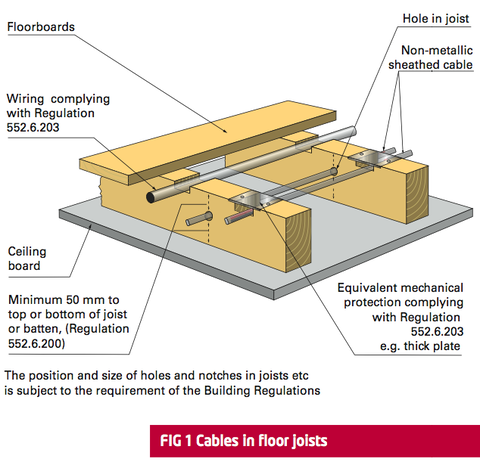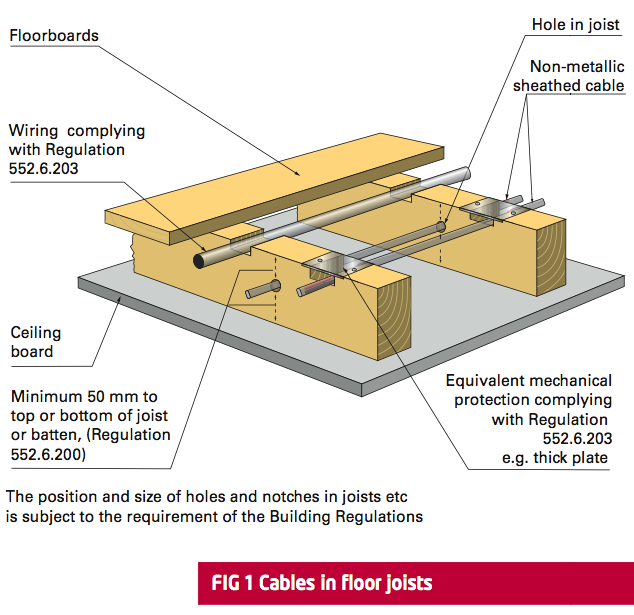Taking you step by step through procedures and requirements for electrical installations. Prior to the introduction of the third amendment of BS 7671, it was permitted, by Regulation 522.6.102, to omit additional protection for cables concealed in walls or partitions in a location that was under the supervision of a skilled or instructed person, however, under the current edition of BS 7671 that permission has been removed.

This article, reviews the current requirements of BS 7671, contained in Section 522.6, for the protection of cables installed within the fabric of the building. Regulation 522.6.200 requires that a cable installed under a floor or above a ceiling is run in such a position that it is not liable to be damaged by contact with the floor, the ceiling or any of their fixings. The regulation also requires that where a cable has to pass through a timber joist within a floor or ceiling construction, or through a ceiling batten, the cable must either:
1. be at least 50 mm measured vertically from the top, or bottom, as appropriate, of the joist or batten,or
2. comply with Regulation 522.6.203.
Cables complying with Regulation 522.6.203
Where protection is provided by use of a cable conforming to the requirements of Regulation 522.6.203 the installed cable should:
- incorporate an earthed metallic covering, such as a steel-wired armour, suitable for use as a protective conductor, or
- be enclosed in metallic conduit, trunking or ducting that is suitable for use as a protective conductor, or
- be provided with additional mechanical protection which is sufficient to prevent penetration of the cable by nails, screws and the like, or
- Form part of a SELV or PELV circuit.

Protection of cables in walls or partitions
A cable installed in a wall or partition can be vulnerable to penetration by nails, screws and the like, which can lead to the danger of electric shock or fire. Because of such risks, cables installed in walls or partitions less than 50 mm from the surface should be routed within the prescribed zones detailed in Regulation 522.6.201 (see Fig 2), unless installed in accordance with Regulation 522.6.203. Where additional mechanical protection is used to satisfy the requirements of 522.6.203 (iv) to prevent penetration of a cable by nails, screws and the like, it must be sufficient to prevent such penetration. It is generally accepted that a protective plate provided to prevent penetration of a cable should be at least 3 mm thick.

Installing cables in prescribed zones
Generally, a zone created on one side of a wall or partition does not extend to the reverse side. However, where the location of the accessory, point or switchgear can be determined from the reverse side, a zone formed on one side of a wall or partition of 100 mm thickness or less extends to the reverse side.

The presence of a doorway means that a person intending to drive a nail, screw or the like into the wall can reasonably determine the location of the accessory from the reverse side of the wall. A mirror image of the permitted cross-shaped zone created in the room with the accessory (room 1) is therefore considered to exist in the other room. Thus, the concealed wiring connected to the accessory is permitted to be within 50 mm of surface of the reverse side of the wall (just as it is permitted to be within 50 mm of the surface with the accessory), provided it is within the mirror image zone. Apart from where the location of accessories, switchgear and the like can be determined from the reverse side, a cable that is installed at a depth of less than 50 mm from either side of a wall or partition has to be in at least one of the permitted zones with respect to that side. The installation of a cable in such a zone, but passing through the box of an accessory rather than connecting to the accessory, is generally considered acceptable.
Additional protection
A cable not conforming to Regulation 522.6.203, such as PVC/PVC (twin and earth) cable, that is installed at a depth of less than 50 mm from the surface of a wall or partition should, in addition to being routed in the zones, be provided with additional protection by an RCD having a residual operating current (IΔn) not exceeding 30 mA.
Walls or partitions constructed of metal parts
Where a cable is installed in a wall or partition that is constructed of, or contains, significant metal parts, there is a risk that damage to the cable could result in causing the metalwork of the wall or partition to become live. Owing to this risk, BS 7671 requires additional protection to be provided for cables in walls or partitions containing significant metal parts irrespective of depth, unless complying with Regulation 522.6.203 or protected against mechanical damage (Regulation 522.6.202 refers). It should be confirmed that the number of socket-outlets or items of equipment controlled by a single RCD are such that the operation of that RCD does not result in unreasonable inconvenience in the event of a fault or, exceptionally, due to excessive protective conductor currents (Regulation 314.1).
- For other guidance and publications please see the NICEIC website.
- Information about the NICEIC Approved Contractor or Domestic Installers schemes,visit www.niceic.com or call 0870 013 0382
